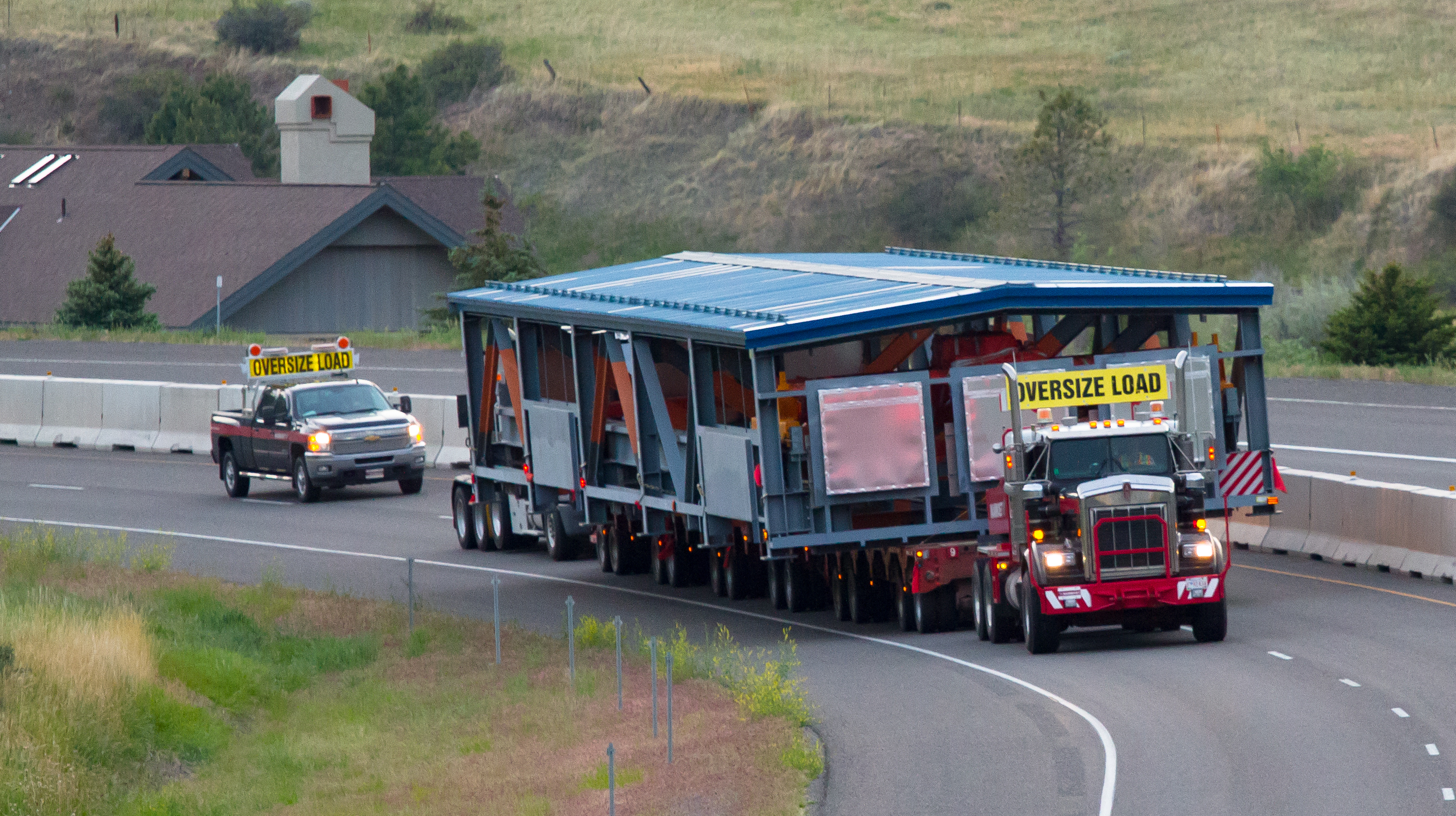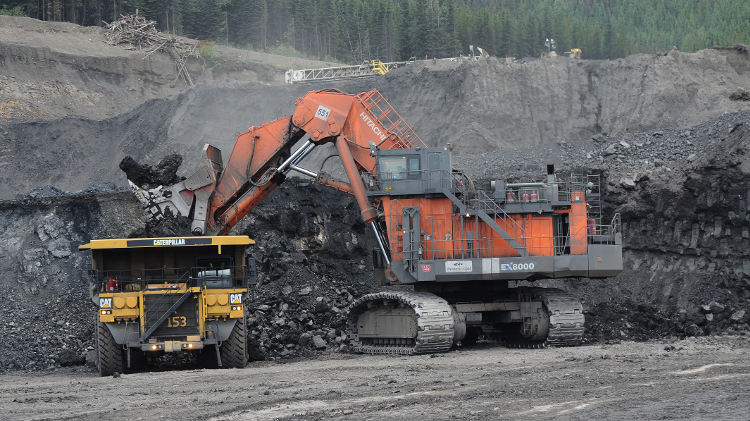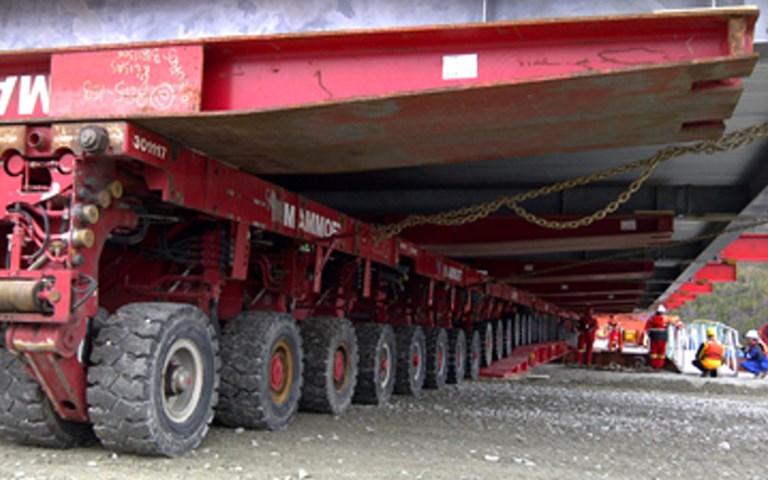Modules were transported to Vale’s Long Harbour site using self-propelled modular transporters. Courtesy of Mammoet
When Vale planned the construction of its nickel processing facility in Long Harbour, Newfoundland and Labrador, off-site modular construction was identified early on as an opportunity for time and cost savings. Vale contracted Netherlands-based Mammoet in 2009 to consult on, and later provide, the transportation of 600 large components to the Long Harbour site. The transportation was done from the middle of 2010 to late 2012, and included 160 modules, weighing up to 1,200 tons, from fabrication yards across North America.
The hydrometallurgical processing plant began commercial production last July.
The US$4.25-billion project was primarily stick-built in Long Harbour, employing more than 6,000 workers. The use of modules for some of the facility allowed Vale to decongest the construction site, as pieces of infrastructure could be built in parallel, rather than sequentially. This approach was particularly important for maintaining the project schedule given the prevailing labour market: in Newfoundland and Labrador – and more broadly in Atlantic Canada – skilled labour was in short supply, with several large-scale industrial projects competing for qualified workers.
“Distributing some of the work to areas outside Atlantic Canada relieved some of the pressure on our timelines and budget,” says Michael Fleming, Long Harbour’s quality and risk manager. “We knew our requirements put us at or near the limits of local labour supply and vendor capacity, so bringing additional resources to bear from outside the region made sense.”
Vale and Mammoet had preliminary meetings in 2007, where Vale expressed interest in modular construction. Glen Aitken, Mammoet’s vice-president of sales for Eastern Canada, says the mining company was keen to explore what could be done. “Vale had a lot of logistical challenges and asked our opinion on many different criteria,” he says. “At the time they seemed skeptical that some of the things could be done, but we were quite confident that it could be built that way.”
Mammoet was involved from the earliest planning stages, first consulting with engineers to allow for a more integrated approach to designing, and then transporting the parts of the facility. The company also reviewed Vale’s chosen fabrication yards’ proximity to wharfs. “When we had sourced the facilities,” explains Dan Donnelly, the former construction manager at Long Harbour, “we got the facilities’ characteristics and capabilities from the owners, and then worked with Mammoet to ensure those facilities could meet project requirements for the barge portion of the job.”
Vale planned in advance the order in which the modules would need to be constructed and delivered to Long Harbour – a process that Donnelly says took about a year. Mammoet began transporting the modules in two phases in mid-2010.
The first phase was the daily transportation of fully constructed modules assembled in Argentia, Newfoundland and Labrador, with the larger modules coming by barge and smaller modules by truck. Phase 1 continued as Phase 2, the sea transport of modules from the three major fabrication yards in Brewer (Maine), Corpus Christi (Texas), and New Iberia (Louisiana) started in early 2011. The transportation job concluded in late 2012. During Phase 2, in addition to the three major fabrication yards, smaller modules and tanks were also barged from a number of other ports and yards in the Great Lakes and Mississippi River system.
“The whole process was truly cross-continental,” says Fleming. “Besides fabrication yards, we engaged suppliers across the Great Lakes area, in Canada and the U.S., which shipped up the St. Lawrence Seaway. Local suppliers played a part too. Mammoet partnered with Hunt’s Transport Ltd., a Newfoundland and Labrador-based company, to carry out a significant amount of the trucking.”
Serious logistical challenges
According to Fleming and Donnelly, around 34,000 pipe welds, 75,000 linear metres of pipe, 15,000 tonnes of steel, 150 kilometres of cable, and 7,000 square metres of building cladding went into the 160 largest modules. Equipment and smaller pipe rack modules were constructed in Argentia, electrical room modules in Maine, building modules in Louisiana, and larger pipe rack modules in Texas.
The modules were shipped by tugboat-pulled barges from the fabrication yards to Long Harbour. At the project’s peak, Aitken says Mammoet had 10 barges cycling between the four major fabrication yards, vendor facilities in the St. Lawrence Seaway, and Long Harbour. He says hundreds of Mammoet employees were involved in the project, including marine engineers in the Netherlands who developed stowage plans for modules on the barges, designed sea-fastening steel fixtures to prevent the modules from shifting in rough seas, and developed towing plans for every barge shipment depending on the geography, time of year and type of modules on board, among other factors.
The weather presented a challenge for Mammoet. Vale wanted year-round delivery, but both summer and winter were difficult transportation seasons. “In the summertime, especially in the Gulf of Mexico, there are a lot of hurricanes or tornadoes,” says Barend Schuring, who at the time was Mammoet’s vice-president of operations for Canada East. “In the winter time, when the Gulf area is more favourable, then there are cold weather and difficult conditions around Newfoundland. There were a lot of times we had to find shelter with a loaded barge to hide from the bad weather, and then start again, to basically make sure the modules, the cargo, every single piece stayed intact.”
Offloading the modules at Vale’s port facility in Long Harbour and transporting them up to the plant construction site also came with its share of logistical issues. The port, which Vale was redeveloping, had originally been constructed in the 1960s and was not designed for handling modules. To avoid damaging the port’s facilities, Mammoet designed and installed fendering to act as a cushion between the quay edge and the arriving barges. The use of 50-foot ramps helped to bridge over the dock, so no heavy loads were placed on the dock’s edge, where it is weakest. “The dock wasn’t ideal for this type of operation, but we made it work,” Aitken says.
On the road up to the site, the modules had to cross over a river. Their heavy weight exceeded the load capacity of the bridge Vale had in place, which was designed to support the long-term operations requirements of the processing plant, so Mammoet had a modular steel bridge built over the existing structure.
There was about a 100-metre elevation difference between the port and the plant site, so Mammoet provided criteria for Vale to design the road with a gentle grade. “Because of the weight and the method of transport of these modules from the port up to the plant site, we had to be careful as to how steep we built the access road,” Donnelly says. “In the end, we kept that road under six per cent grade to allow these modules to be able to travel up it.”
Modular transporters
The modules were moved from the port to the plant site using self-propelled modular transporters (SPMTs).Once they arrived at the plant site, Mammoet staff helped with the installation. “We had to use a lot of different methods to transfer the modules from the SPMTs to the foundations where they were going to be installed permanently,” Aitken says.
A few of the smaller modules were able to be lifted off the SPMTs by crane, but most had to be removed with alternative methods. One technique, called jacking and skidding, involved sliding a module sideways off the SPMT onto steel tracks and jacking it down to the ground using hydraulics. A simpler technique was to drive the module right over its elevated foundation and then set it down with the SPMT’s hydraulics.
Vale’s decision to engage Mammoet at the early stages of construction planning is what transportation experts say they believe should be happening in more modular construction projects. “Vale included Mammoet early on with consulting, so we were involved with a portion of the design before they actually went ahead with it,” says Schuring. “It was very nice they took that effort, because everything lined up a little bit better.”
Getting transportation providers involved in large modular jobs is becoming more common worldwide, Schuring says, but “for our Canada brands, I would say this project was unique because we never were involved that far in advance before.”




